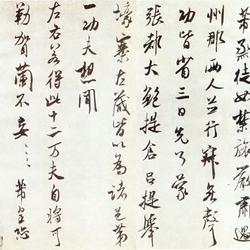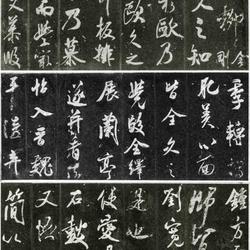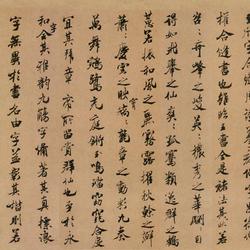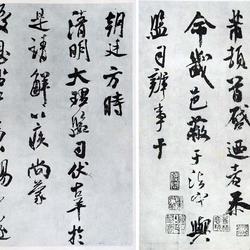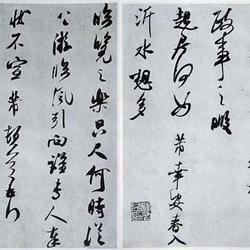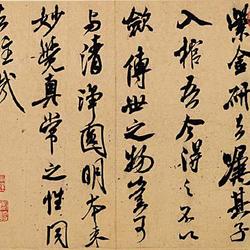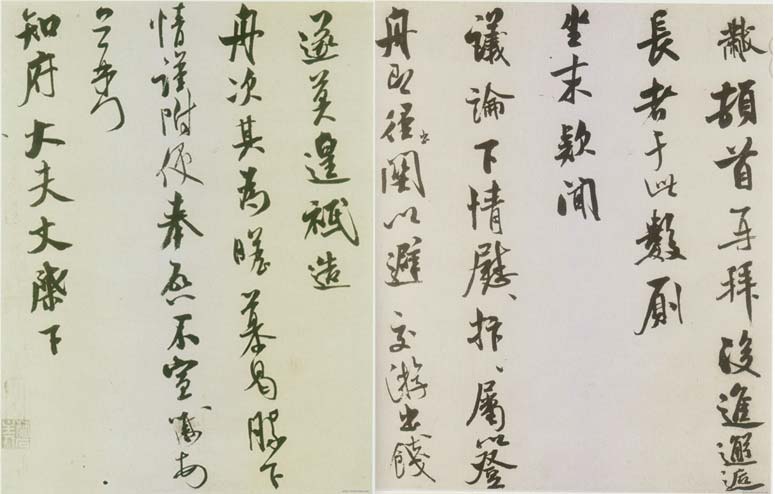
Mi Fu's "Zhifu Tie" (also known as "Elder's Tie"), paper, running script, length 29.8 cm, width 49.6 cm, collected by the National Palace Museum in Taipei. Letter to the Governor
Explanation:
He bowed his head and bowed again. Backward encounter
Elderly people are here, counting the toilets
Sit down and hear the news
Discuss and comfort the dissatisfied. Belongs to Eden
Boat, that is, go out of the customs to avoid friends and travel, and go out to see each other.
Then the last thing to do is to build
Funici. It is for admiration and admiration.
Affection? I would like to entrust you with this, but I will not announce it. He bowed his head and bowed again.
My husband is the magistrate.
Introduction:
This is a letter to the magistrate.
From "I boarded the boat, that is, I went out of the customs to avoid friends and travel," or it was made when Yuanyou returned from Bianjingdong in the second year of his reign.
In the second year of Yuanyou, Mi Fu passed Yongshang (today's Suxian County, Anhui Province), and in June the southern capital was Zhouzhong (Nanjing, Shangqiu). He lived in the Baokang Gate of Bianjing. When he went out, he would wear a high-brimmed hat, sit on the top of his sedan chair, and swagger through the city. Chao described it as a ghost seal. In that year, Su Shi, Su Che, Huang Tingjian, Cai Zhao, Li Zhiyi, Li Gonglin, Chao Buzhi, Zhang Lei, Zheng Jiahui, Qin Guan, Chen Xubi, Wang Qinchen, Liu Jing and Yuantong monk gathered together in the Tang Dynasty. The West Garden of Wang Shen's private residence. Gong Lin made the pictures, and Mi Fu wrote the preface to the collection of poems. At that time, titles such as Luo Party, Shu Party, and Shuo Party appeared in the political arena of the Song Dynasty. The Shu party, headed by Su Shi, had the most people attached to the Shuo party. At this time, the officials in power in the Xining and Yuanfeng dynasties had all retired to idle official positions. Their resentment was soaked in their bones, and they were secretly looking for suspicions of internal strife.
Yu thought that Mi Fu might not want to get involved in political disputes, so he left Bian and left Beijing to avoid making friends and going out for a farewell party.
When Gao Hou lowered the curtain, he ordered to avoid his father Gao Zunfu, so Wenjifu was called Wenji. The word "Fu" is a suspicious name, so I avoid it if I don't have a pen.
The shape of the signature at the end of this post is almost the same as that of "Tiaoxi Shi", and the word "wen" in the door part is also similar to the word "lan" in "Tiaoxi", both of which are composed of Yanxing. But it may be a little early when I write it.
Comment:
Cao Xun of the Song Dynasty's "Song Wen Collection": "Mi Xiangyang's post was especially written in the early years. If it were written later, it would be more heroic and righteous than the Six Dynasties. However, the predecessors intended to recommend more awards, like a frown, Anyone who speaks the truth will praise it, it can inspire the morale of scholars, and everyone will be loyal."
Yuan Qian Kui's postscript: "The elders of Minangong and Ming Gong on the right are strong and dignified, but also graceful and graceful. Su Wenzhonggong said that he has reached the level of the gods, and his comments are true."
Art appreciation:
The glyphs are similar to Mi Fu's 38-year-old "Tiaoxi Poems", but the writing time may be slightly earlier. One of the reasons is the tight structure of the numbers "sitting", "discussing" and "discussing", as well as many starting points. The sharpness of the flanks all have the characteristics of Ouyang Xun, which is relatively rare in "Tiaoxi Poetry". The second reason is that the upward-turning style of the word "游" written next to the water is exactly the same as the word "lake" in "Shu Su Tie" written at the age of 38. Therefore, it seems that this piece of ruler slip was written by Mi Fu when he was about thirty-five years old.
It can also be inferred that this work is a "little work" by Mi Fu. For example, the three characters "Jin En En En Yu" next to each other are similar to each other. This is undoubtedly caused by lack of experience. The radical changes in "Shu Su Tie" are unreasonable and rarely similar, which also provides evidence from another aspect that this book is earlier than "Yuanyou Wuchen".
Although this painting is Mi Fu's "little work", it does not reduce the artistic value of "Zhifu Tie". In the entire layout, in my humble opinion, only the first line has small flaws. The first word "黻" is slightly smaller, and the momentum of the second character "黻" greatly overwhelms the word "黻". This is rare in ordinary cursive works. of. The word "encounter" may be squeezed together for the sake of organizational arrangement, which is a fly in the ointment. The brushwork used in the first six lines is almost the same, with many flaky brushstrokes. This is also one of the major features of Mi Fu's works. Although it is a ruler with small characters, the characters are still full and not thin; starting from the last four lines, the brush strokes switch to a center stroke. There are more, especially below the word "mu". There is less careful brushwork and more affection when writing. The letters are spread out, and the stiff lines combined with thick strokes give the second half a different character.

